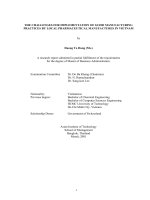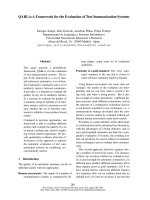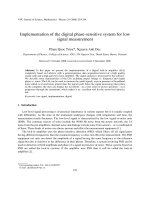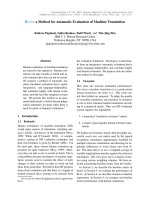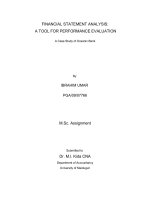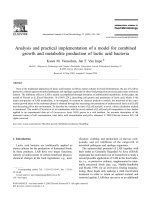Implementation of balanced scorecard for performance evaluation of construction department of phutho tourist limited company
Bạn đang xem bản rút gọn của tài liệu. Xem và tải ngay bản đầy đủ của tài liệu tại đây (538.78 KB, 119 trang )
UNIVERSITE OUVERTE DE HCMV UNIVERSITE LIBRE DE BRUXELLES
ECOLE DE COMMERCE SOLVAY
MMVCFB
PROGRAMME DE MAITRISE EN MANAGEMENT
VIETNAM-COMMUNAUTE FRANCAISE DE BELGIQUE
HOANG VAN BA
IMPLEMENTATION OF BALANCED SCORECARD FOR
PERFORMANCE EVALUATION
OF CONSTRUCTION DEPARTMENT
OF PHUTHO TOURIST LIMITED COMPANY
MASTER DEGREE THESIS IN MANAGEMENT
MMVCFB 6
HO CHI MINH CITY
2007
Implementation of Balanced Scorecard for Performance Evaluation ii
of Construction Department – Phu Tho Tourist Co., Ltd
TABLE OF CONTENTS
Page
Pledge
Acknowledgement
Comments of Professors
Abstract i
Table of Contents ii
Abbreviations viii
List of Figures ix
List of Tables xi
List of Appendices xi
INTRODUCTORY CHAPTER
A. General 1
B. Problem statement 1
C. Objective of research 2
D. Methodology of research 3
E. Scope of research 3
CHAPTER 1
LITERATURE REVIEW
1.1 Organization Strategy Management 5
1.1.1 Strategy 5
1.1.2 Strategic planning 6
1.1.3 Control 6
Master Degree Thesis in Management
Implementation of Balanced Scorecard for Performance Evaluation iii
of Construction Department – Phu Tho Tourist Co., Ltd
1.1.4 Management Control 8
1.2 Management Control system 10
1.2.1 Management Control System and Organizational Goals 10
1.2.2 Designing Management Control System 12
1.2.2.1 Working with the Organization Structure 12
1.2.2.2 Identification of responsibility centers 13
1.2.2.3 Development of measures of performance 13
1.3 Balanced score card: 14
Strategic and performance management system
1.3.1 Balanced scorecard –BSC 14
1.3.1.1. The origin and meaning of BSC 14
1.3.1.2. Why enterprise need the BSC 15
1.3.2 Strategic management system 15
1.3.3 Measurement and evaluation 17
1.3.4 Performance management system 18
1.3.4.1 Performance management cycle 18
1.3.4.2 Performance Management Technique 19
CHAPTER 2
METHODOLOGY & OBJECTIVE OF RESEARCH
2.1. Methodology 23
2.1.1 General 23
2.1.2 Methodology framework 23
2.1.3 Corporate vision and strategy clarification 26
2.1.4 Selecting Business unit 26
Master Degree Thesis in Management
Implementation of Balanced Scorecard for Performance Evaluation iv
of Construction Department – Phu Tho Tourist Co., Ltd
2.1.5 Business unit strategy clarification 26
2.1.6 Business unit KPI development 27
2.1.7 Business unit KPI validation 28
2.1.8 Preparation of data collection 28
2.1.9 Business unit KPI data collection 28
2.1.10 Business unit KPI evaluation 28
2.1.11 Business unit performance analysis 29
2.1.12 KPI concept evaluation 29
2.1.13 Conclusion 29
2.1.14 Recommendation for further study 29
2.2 Construction Department - Phu Tho Tourist 29
2.2.1 Introduce 29
2.2.2 Summary of business actives 30
2.2.2.1 Main product 30
2.2.2.2 Result of business activities 30
2.2.3 Organization Chart 31
2.2.4 Existing problems 31
2.2.5 Construction department 32
CHAPTER 3
CORPORATE STRATEGY FORMULATION, KEY PERFORMANCE
INDICATOR, ANALYSIS AND EVALUATION PERFORMANCE
3.1 Corporate Strategy Formulation 33
3.1.1 General 33
3.1.2 Corporate vision and strategy clarification of Phu Tho Tourist 33
Master Degree Thesis in Management
Implementation of Balanced Scorecard for Performance Evaluation v
of Construction Department – Phu Tho Tourist Co., Ltd
3.1.2.1 Planning 33
3.1.2.2 Implementation 34
3.1.2.3 Result 34
3.1.2.4 Evaluation 35
3.1.3 Selecting Business unit 36
3.1.4 Construction department strategy clarification 36
3.1.4.1 Planning 36
3.1.4.2 Implementation 36
3.1.4.3 Result 37
3.1.4.4 Evaluation 38
3.2 Key performance indicator development 38
3.2.1 General 38
3.2.2 KPIs development of construction department 38
3.2.2.1 Planning 38
3.2.2.2 Implementation 38
3.2.2.2.1 Translate strategy of construction department 38
3.2.2.2.2 Develop Construction Department Strategic map 40
3.2.2.3 Develop business unit KPI 41
3.2.2.4 Planning 43
3.2.2.5 Implementation 44
3.2.2.5.1 Finalize construction objective 46
3.2.2.5.2 Finalize construction department KPIs 51
3.2.2.5.3 Develop KPIs weighting 52
3.2.2.6 Evaluation 58
Master Degree Thesis in Management
Implementation of Balanced Scorecard for Performance Evaluation vi
of Construction Department – Phu Tho Tourist Co., Ltd
3.3 Performance evaluation, analysis 58
3.3.1 General 58
3.3.2 Preparation of data collection 59
3.3.2.1 Planning 59
3.3.2.2 Implementation 59
3.3.3 Business unit KPIs data collection 62
3.3.3.1 Planning 62
3.3.3.2 Implementation 62
3.3.3.3 Result 62
3.3.4 Business unit KPIs Evaluation 63
3.3.4.1 Planning 63
3.3.4.2 Implementation 64
3.3.4.3 Result 64
3.3.5 Construction department performance Analysis 64
3.3.5.1 Planning 64
3.3.5.2 Implementation 65
3.3.5.3 Calculation technique and result 68
3.3.5.4 Construction department performance analysis 73
3.3.6 KPI concept evaluation 79
3.3.6.1 Planning 79
3.3.6.2 Implementation 80
Master Degree Thesis in Management
Implementation of Balanced Scorecard for Performance Evaluation vii
of Construction Department – Phu Tho Tourist Co., Ltd
CHAPTER 4
CONCLUSIONS AND RECOMENDATION
4.1. Summary of implementation process 82
4.2. Results and provident recommendation 82
4.2.1. Results 82
4.2.2. Improvement recommendation 83
4.3. Investigation of balanced scorecard implementation problem 84
4.4. Recommendation for BSC concept implementation problem 85
4.5. Recommendation for further study 89
References
Master Degree Thesis in Management
Implementation of Balanced Scorecard for Performance Evaluation viii
of Construction Department – Phu Tho Tourist Co., Ltd
LIST OF ABBREVIATIONS
ABBREVIATIONS MEANING
¬ BSC Balanced Scorecard
¬ Construction Dept Construction Department
¬ KPI Key performance indicator
¬ KPIs Key performance indicators
¬ HCMC Ho Chi Minh city
¬ Phu Tho Tourist Phu Tho Tourist limited company
¬ USA United state of American
¬ VND Vietnam Dong
Master Degree Thesis in Management
Implementation of Balanced Scorecard for Performance Evaluation ix
of Construction Department – Phu Tho Tourist Co., Ltd
LIST OF FIGURES
Figure 1.1 Management process 7
Figure 1.2 Element of the Control Process 8
Figure 1.3 Frameworks for Strategy Implementation 9
Figure 1.4 The Management control system 10
Figure 1.5 Managing Strategy: Four Processes 17
Figure 1.6 The Stages of Performance Management 19
Figure 1.7 The Balanced Scorecard Links Performance Measures 21
Figure 1.8 Cause and effect relation in balanced scorecard 22
Figure 2.1 Methodology Frameworks 25
Figure 2.2 Organization chart of Phu Tho Tourist 31
Figure 3.1 Corporate vision and strategies 35
Figure 3.2 Strategies of Construction Department 37
Figure 3.3 Translation Construction Department Strategy 40
Figure3.4 Preliminary Business Unit Strategic Map 41
Figure 3.5 KPIs valuation process 43
Figure 3.6 Business unit strategic Map 47
Figure 3.7 KPI weighting 58
Figure 3.8 Finance perspective performance scale 73
Figure 3.9 Customer perspective performance scale 75
Figure 3.10 Internal business process perspective performance scale 76
Figure 3.11 Learning and Growth perspective performance scale 78
Figure 3.12 Overall performance scale of construction department 79
Master Degree Thesis in Management
Implementation of Balanced Scorecard for Performance Evaluation x
of Construction Department – Phu Tho Tourist Co., Ltd
LIST OF TABLES
Table 2.1 Revenue in past five years 30
Table 3.1 Preliminary Business Unit KPIs 42
Table 3.2 Summary result from KPIs validation 45
Table 3.2 Summary result from KPIs validation (continue) 46
Table 3.3 Construction dept goal and objective due to finance perspective 48
Table 3.4 Construction dept goal and objective due to customer perspective 49
Table 3.5 Goals and objective due to internal business process perspective 50
Table 3.6 Goal and objective due to Learning and Growth perspective 51
Table 3.7 Construction department KPIs 52
Table 3.8 Summary of KPIs weighting 57
Table 3.9 Construction department KPIs Source of data 60
Table 3.9 Construction department KPIs source of data (continue) 61
Table 3.10 Summary result collecting data of KPIs 63
Table 3.11 Result KPIs Evaluation 66
Table 3.11 Result KPIs Evaluation(continue) 67
Table 3.12 Performance scale calculation 71
Table 3.12 Performance scale calculation (continue) 72
Table 3.13 Finance perspective performance scale 73
Table 3.14 Customer perspective performance scale 74
Table 3.15 Internal business process perspective performance scale 76
Table 3.16 Learning and Growth perspective performance scale 77
Table 3.17 Overall performance scale of construction department 79
Table 4.1 The summary of Problem Identification and Recommendation 88
Master Degree Thesis in Management
Implementation of Balanced Scorecard for Performance Evaluation xi
of Construction Department – Phu Tho Tourist Co., Ltd
LIST OF APPENDICES
Appendix A: Validation of KPIs of Construction Department
Appendix B: The result of validation of KPIs of Construction Department
Appendix C: Weight analysis of KPIs of Construction Department
Appendix D: Data collection form
Appendix E: Result of KPIs valuation
Appendix F: Performance scale
Master Degree Thesis in Management
Implementation of Balanced Scorecard for performance evaluation
of Construction Department – Phu Tho Tourist Co., Ltd
PLEDGE
I pledge that this thesis is my research work. The data and results which
were presented in the thesis are absolutely honest.
Hoang Van Ba
Master Degree Thesis in Management
Implementation of Balanced Scorecard for performance evaluation
of Construction Department – Phu Tho Tourist Co., Ltd
ACKNOWLEDGEMENTS
I wish to express my profound gratitude and great appreciation to my Guidance
Counselor Dr. Nguyen Cong Thanh for his valuable guidance, advice and
encouragement throughout the research study.
Taking this opportunity, I would also like to thank all professors, coordinators,
tutors in Vietnam - Belgium Master in Management programme, and my
classmates for their assistance and co-operation during my two-year’s time at the
course.
A grateful acknowledgement is extended to general director board, managers of
construction department, managers of other departments, director of subsidiaries
and my colleagues at Phu Tho Tourist limited company for assistance, providing
me with materials needed for the research.
I remain indebted to my beloved family, relatives and friends for their valuable
encouragement and unceasing supports in my academic pursuits.
Hoang Van Ba
Master Degree Thesis in Management
Implementation of Balanced Scorecard for performance evaluation i
of Construction Department – Phu Tho Tourist Co., Ltd
ABSTRACT
To manage business function of company is one of the most difficult tasks
because each business function has unique character. Since now, there is no
proper and effective system for managing performance of business unit of Phu
Tho Tourist limited company. This study is conducted in order to identify the
most appropriate business function for applying the performance measurement
system focused balanced scorecard concept, to identify relevant and appropriate
Key Performance Indicators (KPIs) and to implement investigate and
recommend the concept implementation problem. The balanced scorecard is an
appropriate tool to identify KPIs because it integrates four critical perspectives
such as financial, customer, internal business process, and learning and growth
perspectives. The construction department of Phu Tho Tourist company, was
selected as business unit for the concept implementation. To ensure the
practicality of KPIs, the management team of company and the construction
department performed the KPI validation. Therefore, the completed sets of KPIs
with weight are systematically developed. Thereafter, the performance of
construction department was evaluated based on the information of projects of
the company in 2006. As the results, the study developed the recognition areas
for the concept implementation problem as well as the recommendations. The
most critical factor for the concept implementation is the commitment from all
participants. Therefore, appropriate KPIs can be used as an effective
performance management system of the construction department.
Master Degree Thesis in Management
Implementation of Balanced Scorecard for Performance Evaluation 1
of Construction Department – Phu Tho Tourist Co., Ltd
INTRODUCTORY CHAPTER
A. General
Vietnamese economy has been in the context of developing and integrating
process with the world economy. In order to exist and grow in the tense
competition, companies has to formulate the right vision and strategy, to tranfer
them to real activities of the company. To identify how the trategy be excuted,
and if it be well done, the companies has to conduct measuring the performance
of the strategy.
Performance measurement is one of the essential factors for organization
management. However, managers see the importance of performance
measurement, but more concerned on planning and performing this strategy.
Due to ability to sustain in the situation of high and rapid change in competitive
market, organization must adopt effective tool for measuring and evaluating their
performance continuously (Dacharin, 2001). Therefore, performance
measurement is the process of organization determining how successful
organizations or individuals have been in achieving their objectives.
B. Problem statement
All of companies have faced to problems in operation process. However, almost
those problems have warning sign at the first stage of them. If we can carry out
diagnosing or measuring, we will discover them before they become serious and
out of our control. We could put forward the correlative solutions to them.
If companies conduct to measure and diagnose during management cycle
continuously, they can understand better of using resources. The result of
performance is factor to conference to allocating the resources in the future of
Master Degree Thesis in Management
Implementation of Balanced Scorecard for Performance Evaluation 2
of Construction Department – Phu Tho Tourist Co., Ltd
company. The performance measurement will help to increase the operation
effect of company.
Due to the importance mentioned above, strategy of organization should be
revised or designed accordingly. However, companies may not have any
effective technique to manage or modify their strategy due to the changing of
business environment. Moreover, they are lack of an effective method to
evaluate their strength and weakness, which can be used to identify their
standing position in the market. Thus, making some improvement in the
organization will be very difficult and ineffective. As the result above, the
organization is lacking of ability to sustain in the competitive market. Therefore,
organization performance evaluation tool must be appropriately designed.
C. Objective of research
Major objective of this study is to apply performance measurement system into
organization upon the concept of the Balanced Scorecard.
In order to accomplish the main objective, the following sub objectives must be
fulfilled.
1. Identify the core business unit that appropriate for applying of Balanced
Scorecard concept.
2. Apply the performance measurement system focused Balanced Scorecard
in the business unit in order to investigate implementation problem.
Therefore, recommendation for the problem solving could be formulated.
The following programs are included:
• Verification of business strategy and corporate vision
• Development of the business unit Key Performance Indicators
(KPIs): selected business unit
Master Degree Thesis in Management
Implementation of Balanced Scorecard for Performance Evaluation 3
of Construction Department – Phu Tho Tourist Co., Ltd
• Development of KPIs implementation
D. Methodology of research
Methodology of study combines many methodologies which become unifying
methodology. Basing on balanced scorecard concept, collecting data, figure,
interviewing managers, quantitative analysis, form the steps of study as
following:
Step 1: Clearing the corporate the vision and strategy
• Clearing the vision and strategy
• Selecting business unit to survey
• Verification the selected business unit
Step 2: Developing key performance indicators- KPIs
• Developing key performance indicators - KPIs: to deploy business unit
strategy into balanced scorecard aspects, strategic relation map, key
performance indicators.
• Quantify, develop key performance indicators of business unit.
Step 3: Development of key performance indicators implementation:
• Preparing and collecting data of KPIs
• Quantifying KPIs
• Analyzing performance of business unit
• Evaluating the performance through KPIs
Stage four: Conclusion and Recommendation
• Conclusion
• Recommendation for the further study
E. Scope of research
Master Degree Thesis in Management
Implementation of Balanced Scorecard for Performance Evaluation 4
of Construction Department – Phu Tho Tourist Co., Ltd
Study focus on balanced scorecard to evaluate the performance of Construction
department – Phu Tho Tourist limited company.
• Persons who involve the research are general director board, managers of
business unit.
• Company address: 2 street 15 Lu gia housing compound, ward 15, district
11, HCMC
• Data be collected in 2003 -2006
• Data using to benchmark be collected from document of control of
investing construction of government promulgated
Master Degree Thesis in Management
Implementation of Balanced Scorecard for Performance Evaluation 5
of Construction Department – Phu Tho Tourist Co., Ltd
CHAPTER 1
LITERATURE REVIEW
1.1 Organization Strategy Management
1.1.1 Strategy
Strategy is defined as a comprehensive plan of action that set a critical direction
and guides the location of resources to achieve long-term organization
objectives. Michael E.Porter (1996) stated three conceptions about strategy.
First, strategy is creation of valuable position involving different actions. Second,
strategy is choice, exchange in competition. The core point is to discriminate
necessary things and vice versa. Third, strategy makes the suitability between
activities of company. The success of strategy replies on good performance,
integration and unify of activities.
In practice, the choice of strategy is a complex and even risk task. Any strategy
defines the direction in which an organization intends to move in a competitive
environment. It is the choice that specifies how managers plan to match the
organization’s strengths and weaknesses with opportunities and threats in the
environment (John R, 1996). The goal of strategy is to seek the opportunity, in
other word, to increase chances and get competitive position (Nguyen Thi Lien
Diep, 2003).
In addition to the definition mentioned above, strategy also involves goal setting
and the planning need to attain goals. It also involves translating plans into
programs and monitoring programs to make sure that remain goal directed.
Strategy is pertinent to two levels within the enterprise: the corporate level and
the strategic business unit level.
Master Degree Thesis in Management
Implementation of Balanced Scorecard for Performance Evaluation 6
of Construction Department – Phu Tho Tourist Co., Ltd
1.1.2 Strategic planning
Strategic plan is a plan that set the overall goals and objectives of the
organization. The strategic plan leads to long-range planning, which produces
forecasted financial statements for five to ten-year period. The financial
statements are estimated of what manager would like to see in the company’s
future financial statements. Decisions made during long-range planning include
addition or deletion of product lines, design and location of new plants,
acquisition of buildings and equipments, and other long-term commitments.
Long-range plans are coordinated with capital budget which details the
expenditures for facilities, equipments, new products, and other long-term
investments. Long-range plans and budgets give the company direction and goals
for the future, while short-term plans and budgets guide day-to-day operations.
(Horngren et al., 1999)
Structured planning is an effective management control system. Through
planning, managers anticipate the inherent risks in their activities and set up
methods to mitigate the effects of these risks. (David, 1999)
The Strategic Planning Process is the process of converting the Business
Objectives and the Appreciation of Business Risk into a set of strategic
objectives, scenarios, plans, or the like to serve as guidance for the organization
over some planning horizon greater than one year (David and Georges, 1999)
1.1.3 Control
Controlling refers to implementing plans and using feedback to attain objectives.
Feedback is crucial to the cycle of planning and control. Planning determines
action, action generate feedback, and feedback influences further planning.
Master Degree Thesis in Management
Implementation of Balanced Scorecard for Performance Evaluation 7
of Construction Department – Phu Tho Tourist Co., Ltd
Planning
(Deciding)
Action
(Implementing
Evaluation
(Feedback)
Controlling
Figure 1.1 Management process
Function of controlling are measurement and adjustment in implementation task,
in order to ensure goals and plans be fulfilled.
Controlling process includes three steps:
- Establishing criteria
- Measuring performance following those criteria
- Adjusting the difference between criteria and plans
Any control system has at least four elements:
- A detector or sensor, which is a measuring device that identifies what is
actually happening in the process being controlled.
- An assessor, which is a device for determining the significance of what is
happening. Usually, significance is assessed by comparing the information
on
what is actually happening with some standard of expectation of what
should be happening.
- Effectors, which are a device that alters behavior if assessor indicates the
need for doing so. This device is often called “feedback.”
Master Degree Thesis in Management
Implementation of Balanced Scorecard for Performance Evaluation 8
of Construction Department – Phu Tho Tourist Co., Ltd
- A communication network transmits information between the detector and
the assessor and between the assessor and the effectors.
These basic elements of a control system are as shown in Figure 1.2.
Figure 1.2 Element of the Control Process (Robert and Vijay, 1998)
Control
device
Entity being
control
3. Effectors,
behaviour
alteration, if
need
2. Assessor,
comparison with
standard
1. Detector,
information
about what
is happening
1.1.4 Management Control
Management control is one of several types of planning and control activities
that occur in the organization. Management control fits between strategy
formulation and task control in several aspects.
Management control is the process by which managers influence other members
of the organization to implement the organization’s strategies. Management
control involves many activities such as: (1) planning what the organization
should do, (2) coordinating the activities of several parts of the organization, (3)
communicating information, (4) evaluating information, (5) deciding what action
should be taken, and (6) influencing people to change their behavior.
Management control anticipates what conditions are going to be in the future.
The purpose of management control is to ensure that strategies are carried out so
that the organization’s objectives are attained.
Master Degree Thesis in Management
Implementation of Balanced Scorecard for Performance Evaluation 9
of Construction Department – Phu Tho Tourist Co., Ltd
Although systematic, the management control process is by no means
mechanical. The process involves interactions among individuals. Managers
have personal goals, and the central control problem is to induce them to act so
that when they seek their personal goals, they will help to attain the
organizational goals. The goals of individual members of an organization should
be consistent with the goals of the organization.
Management control systems aid management in moving an organization toward
its strategic objectives. Management controls are the tools that managers use in
implementing desired strategies. As indicated in Figure 1.3, strategies get
implemented through management control, organization structure, human
resource management, and culture. Organization structure specifies toe roles,
reporting relationships, and responsibilities that shape decision making within
organizations. Human resource management deals with selection, training,
development, evaluation, promotion, and firing employees. Culture refers to the
organization’s set of common beliefs, attitudes, and norms that explicitly or
implicitly guide managerial actions.
Figure 1.3 Frameworks for Strategy Implementation (Horngre et al., 1999)
Culture
Management
control
Human resource
management
Organization
structure
Performance
Strategy
Implementation Mechanism
Master Degree Thesis in Management
Implementation of Balanced Scorecard for Performance Evaluation 10
of Construction Department – Phu Tho Tourist Co., Ltd
1.2 Management Control system
1.2.1 Management Control System and Organizational Goals
A well-designed management control system aids and coordinates the process of
making decisions and motivates individuals throughout the organization to act in
concert. It also facilitates forecasting revenues- and cost-driver levels,
budgeting, and measuring and evaluating performance. (Horngre et al., 1999)
The first and most basic component in a management control system is the
organization’s goals. As shown in Figure 1.4, setting goals, objectives and
performance measures, and targets, manager reviews these goals on a periodic
basis, usually once a year, but normally they do not change them. These goals
provide a long-term framework around which an organization will form its
comprehensive plan for positioning itself in the market. As Figure 1.4 shows,
goals answer the question, “What do we want to achieve?” However, goals
without performance measures do not motivate managers.
Figure 1.4 The Management control system (Horngre et al.,1999)
Monitor, Report
Set Goals,
Measures,
Tar
g
ets
Evaluate,
Reward
Plan and
Execute
Feedback and
Learnin
g
What do we want to achieve?
H
ow
do
we
set
t
h
e
d
ir
ect
i
o
n
?
Are we
encouraging
the right
behaviour?
What is
getting in
our way?
How much progress
a
r
e
we
m
a
kin
g?
Master Degree Thesis in Management
Implementation of Balanced Scorecard for Performance Evaluation 11
of Construction Department – Phu Tho Tourist Co., Ltd
The purpose of performance measures is to set direction and to motivate
managers. Targets for goals are specific quantified levels of the measures.
As we can see, goals and their related performance measures are very broad. In
fact, they are often too vague to guide managers and employees. As a result, top
managers also identify critical processes and key success factors.
A critical process is a series of related activities that directly affects the
achievement of organizational goals. The next step in goal setting is for both top
managers and the managers of the critical processes to develop sub goals or key
success factors and related performance measures. Key success factors are
actions that must be done well in order to drive the organization towards its
goals.
Although, key success factors and related performance measures give managers
more focus than do overall, organization-wide goals, they still do not give lower-
level managers and employees the direction they need to guide their daily
actions. To set this direction, critical process managers work with lower-level
mangers within the appropriate business unit to establish objectives-specific
tangible actions (activities) that can be observed on a short-term basic.
Balancing the various objectives is an important part of management control.
Sometimes the management control system ignores critical success factors or
inadvertently emphasizes the wrong factors. Managers often face trade-off
decisions. For example, a sales manager can increase the “employee
satisfaction” measure (a survey of employees) by setting lower standards for
responding to customer inquiries. This action may improve the employee
satisfaction measure of the manager but result in unsatisfied customers.
Management control systems play an important part in the perception of risk.
Master Degree Thesis in Management
